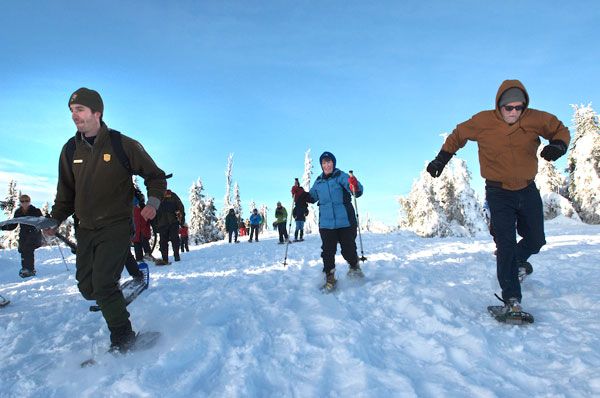On the Trail
Ross Coyle
The best time to see Olympic National Park isn’t during the spring or summer but in the winter when the snows create a world that would make Dr. Seuss envious.
On the back face of Hurricane Ridge, snow drapes itself upon the subalpine fir trees in graceful arcs, turning the world into a fantasy land. A hike out to a vista point reveals smooth snowdrifts leading to the jagged peaks of the Olympic Mountains.
Hiking in the snow isn’t easy, though, and getting to the vistas and the terrain away from high traffic areas requires the use of snowshoes. While they are a bit of an investment, the activity is a good way for anyone to stay active in the winter and see unique scenery.
“When it comes to outdoor recreation, one of the amazing things about snowshoeing is that it’s one of the things the whole family can do,” says National Park Ranger Josh McLean, who leads snowshoe hikes during the weekend at Hurricane Ridge.
“On my walks I’ve had kids as young as 3 or 4 and adults up to 85 years old,” he says.
McLean also says that snowshoeing is a more intimate form of winter cross-country travel.
“When you’re cross-country or backcountry skiing, it’s not easy to stop and take stock of your environment,” McLean says. “On snowshoes you get to interact directly with an environment that you just don’t see in your day-to-day life.”
Get equipped
Snowshoes can be purchased at a number of stores, with budget models available at Costco and more premium models available at outdoors retailers such as REI in Seattle or Brown’s Outdoor Store in Port Angeles. For those who want to rent, Brown’s provides rental shoes for $15 per day and Hurricane Ridge offers them for $37 per day.
When buying snowshoes, it’s important to choose the appropriate deck or center platform portion of the shoe.
Decks vary in construction from solid plastic to a neoprene-style webbed material. Different materials have different effects on the shoe’s performance. While plastic is cheaper and more durable, it’s also noisier and less conforming to the hard snow. Webbing costs more but is more flexible and conforms to packed snow. Another alternative is to buy used snowshoes.
Evan Brown, owner of Brown’s Outdoor Store, says that this is a viable option, but stresses the importance of checking shoe bindings to make sure they aren’t worn out. “You don’t hear as many complaints about the actual snowshoe” he says of used gear. “It’s usually the binding.”
Many snowshoe kits come with hiking/trekking poles, and while these aren’t necessary, Brown suggests buying a pair to help distribute weight and get used to the different dynamics of hiking on snowshoes.
Pick a trail
Brown recommends several trails depending on snowshoeing experience. Those new to the activity should start up on Hurricane Ridge, which features several different short snowshoe trails and allows newcomers to get their feet snowy. He recommends hiking the road from the visitor center to Hurricane Hill. The short one-mile trek to the end of the unplowed road can be extended by a half mile to the top of Hurricane Hill.
Intermediate snowshoers can tackle the Obstruction Point Road trail. The route runs eight miles round trip to PJ Lake over an unplowed road, provides excellent views of Mount Olympus and other southern peaks, and crosses underneath the landmark Steeple Rock.
While the sport is fun, it has its hazards and experts say it’s important for newbies to remember a few crucial tips.
“If you’re going out snowshoeing, you’re going into an environment that is much less forgiving, so good preparation is critical,” McLean says. Hikers should have proper clothing and ideally the 10 hiking essentials: map, compass, sunscreen, warm clothing,flashlight, first aid, firestarter, water, knife and food. A compass is invaluable, he says, if hiking at a distance from the visitor center.
Brown also points out that snowshoes cut your speed in half, so plan to give twice as much time to whatever route you take. Also, he warns of the dangers of avalanches, which can be assessed at ranger stations. The safest way to avoid avalanches is through experience and McLean suggests cross-country hiking only with experienced people who can assess conditions.
“If you’ve never cross-countried in the wintertime, you need someone with you that has,” McLean warns.
Get started
Those looking to get into snowshoeing can start at the Hurricane Ridge Visitor Center, where snowshoe walks are offered Saturdays and Sundays at 2 p.m.
Call the Olympic National Park Visitor Center at 360-565-3130 or check online at www.nps.gov/olym.



